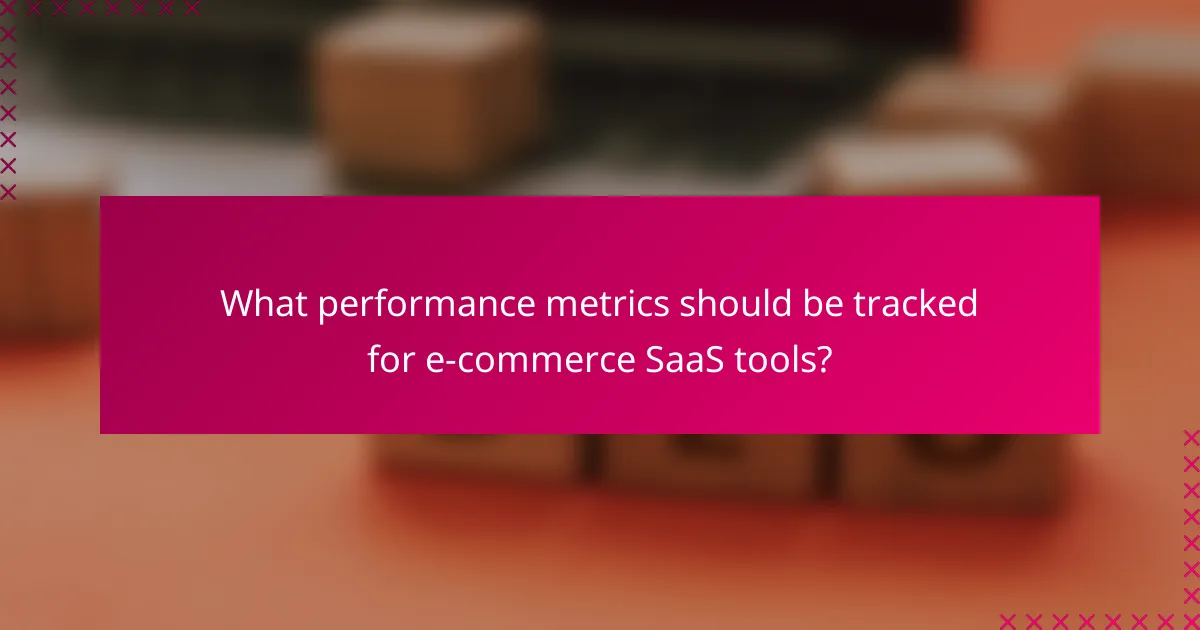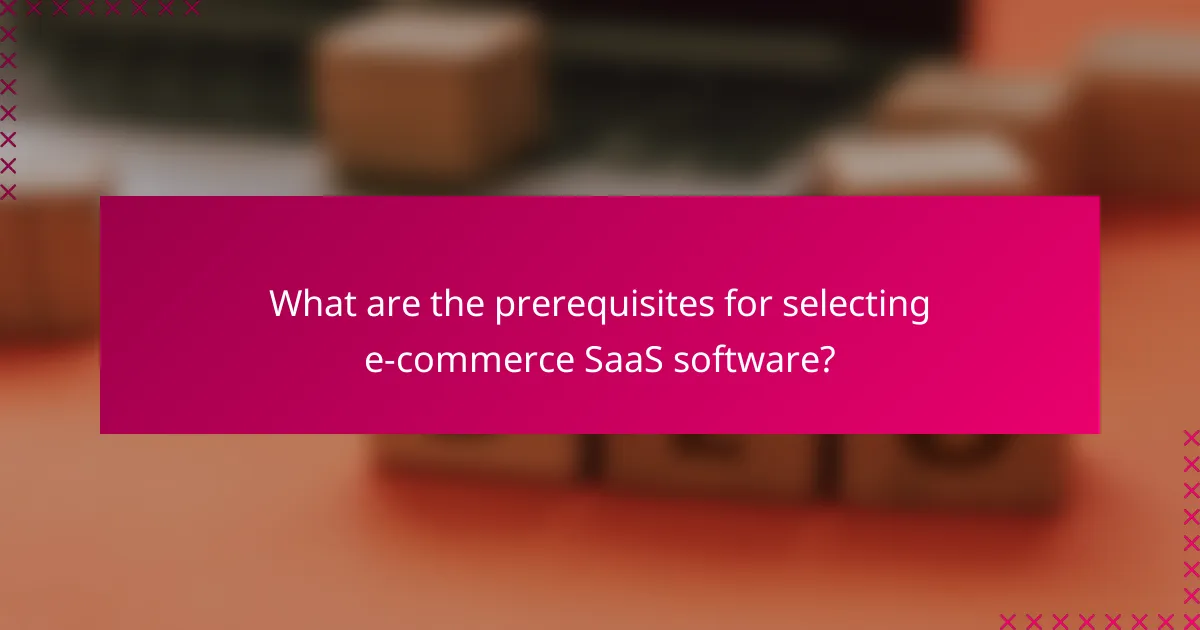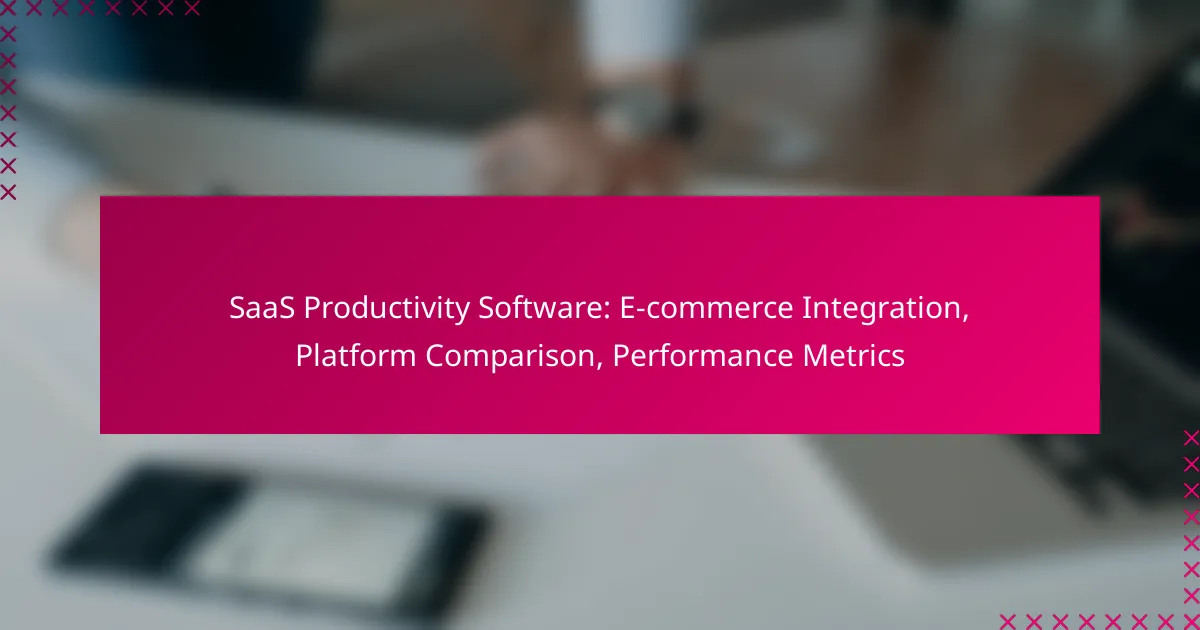In the rapidly evolving landscape of e-commerce, selecting the right SaaS productivity software is crucial for optimizing operations and enhancing customer experiences. Platforms like Shopify, BigCommerce, and WooCommerce offer unique features tailored to various business needs, making it essential to compare their integration capabilities and overall functionality. Additionally, tracking performance metrics such as conversion rates and customer acquisition costs is vital for assessing effectiveness and refining business strategies.

What are the best SaaS productivity software for e-commerce integration in Canada?
The best SaaS productivity software for e-commerce integration in Canada includes platforms that streamline operations, enhance customer experience, and provide robust analytics. Key options to consider are Shopify, BigCommerce, WooCommerce, Magento, and Salesforce Commerce Cloud, each offering unique features tailored to different business needs.
Shopify
Shopify is a leading e-commerce platform known for its user-friendly interface and extensive app ecosystem. It allows businesses to set up online stores quickly and offers various integrations with payment gateways, shipping services, and marketing tools.
Canadian businesses benefit from Shopify’s local payment options, including support for Interac and various currency settings. Additionally, Shopify provides built-in analytics to track sales performance and customer behavior, helping businesses make informed decisions.
BigCommerce
BigCommerce is another robust e-commerce solution that caters to growing businesses with its scalability and flexibility. It offers advanced features like multi-channel selling, allowing integration with platforms such as Amazon and eBay.
For Canadian merchants, BigCommerce supports local tax calculations and currency conversions, making it easier to manage sales across different regions. Its comprehensive reporting tools help businesses analyze performance metrics effectively.
WooCommerce
WooCommerce is a popular plugin for WordPress that transforms a standard website into a fully functional e-commerce store. It is highly customizable, allowing businesses to tailor their online presence to specific needs.
Canadian users can take advantage of various payment gateways and shipping options available through WooCommerce. The platform’s extensive community and resources make it easier for users to find support and enhance their store’s capabilities.
Magento
Magento is a powerful e-commerce platform suitable for larger businesses with complex needs. It offers extensive customization options and robust features for managing large product catalogs and multiple storefronts.
For Canadian businesses, Magento provides tools for local compliance, including tax management and currency support. However, it requires more technical expertise to set up and maintain compared to simpler platforms like Shopify or WooCommerce.
Salesforce Commerce Cloud
Salesforce Commerce Cloud is an enterprise-level solution that integrates e-commerce with customer relationship management (CRM). It focuses on delivering personalized shopping experiences and advanced analytics.
Canadian businesses can leverage Salesforce’s powerful data-driven insights to optimize marketing strategies and improve customer engagement. However, it is typically more expensive and may be best suited for larger organizations with significant resources.

How do these platforms compare in terms of features?
When comparing SaaS productivity software for e-commerce, key features include integration capabilities, user experience, and overall functionality. Understanding these aspects helps businesses choose the right platform to enhance their operations and streamline processes.
Feature comparison chart
A feature comparison chart provides a visual representation of the capabilities of different SaaS platforms. Key features to consider include inventory management, order processing, customer relationship management (CRM), and reporting tools.
| Platform | Inventory Management | Order Processing | CRM | Reporting Tools |
|---|---|---|---|---|
| Platform A | Yes | Automated | Basic | Advanced |
| Platform B | Yes | Manual | Advanced | Basic |
| Platform C | No | Automated | Basic | Intermediate |
Integration capabilities
Integration capabilities are crucial for e-commerce platforms, as they determine how well the software connects with other tools like payment processors, shipping services, and marketing applications. Look for platforms that offer APIs and pre-built integrations to streamline workflows.
Consider the ease of integration; some platforms may require extensive setup while others offer plug-and-play solutions. For example, platforms that support popular e-commerce solutions like Shopify or WooCommerce often provide smoother integration experiences.
User experience ratings
User experience ratings reflect how intuitive and efficient a platform is for end-users. High ratings typically indicate a user-friendly interface, quick navigation, and effective customer support, which are essential for maintaining productivity in e-commerce operations.
When evaluating user experience, check reviews on platforms like G2 or Capterra. Aim for software that consistently scores above average in usability, as this can significantly reduce training time and improve overall satisfaction among team members.

What performance metrics should be tracked for e-commerce SaaS tools?
Tracking performance metrics for e-commerce SaaS tools is essential for understanding their effectiveness and optimizing business strategies. Key metrics include conversion rates, average order value, customer acquisition cost, and return on investment, each providing insights into different aspects of your e-commerce operations.
Conversion rates
Conversion rates measure the percentage of visitors who complete a desired action, such as making a purchase. A higher conversion rate indicates that your website effectively persuades visitors to buy. Aim for a conversion rate of around 2-5% for e-commerce sites, but this can vary based on industry and target audience.
To improve conversion rates, focus on optimizing your website’s user experience, including fast load times, clear calls to action, and mobile responsiveness. Regularly A/B test different elements such as product pages and checkout processes to identify what resonates best with your customers.
Average order value
Average order value (AOV) calculates the average amount spent by customers per transaction. Increasing AOV can significantly boost revenue without needing to acquire more customers. AOV can vary widely, but many e-commerce businesses aim for a range of $50 to $150, depending on their niche.
To enhance AOV, consider implementing upselling and cross-selling strategies, offering bundle deals, or providing free shipping on minimum purchase amounts. Monitoring AOV regularly helps identify trends and adjust marketing strategies accordingly.
Customer acquisition cost
Customer acquisition cost (CAC) is the total expense incurred to acquire a new customer, including marketing and sales costs. Understanding CAC is crucial for evaluating the efficiency of your marketing efforts. A typical CAC for e-commerce businesses can range from $30 to $150, depending on the industry and marketing channels used.
To lower CAC, focus on optimizing your marketing campaigns and leveraging organic traffic through SEO and content marketing. Regularly analyze the performance of different channels to allocate your budget more effectively and maximize return on investment.
Return on investment
Return on investment (ROI) measures the profitability of your e-commerce initiatives relative to their costs. A positive ROI indicates that your investments are generating more revenue than they cost. For e-commerce, a common benchmark is to aim for an ROI of at least 20-30%.
To improve ROI, carefully track all expenses associated with your e-commerce operations and compare them against generated revenue. Focus on high-impact strategies that yield the best returns, and continuously refine your approach based on performance data to ensure sustainable growth.

What are the prerequisites for selecting e-commerce SaaS software?
When selecting e-commerce SaaS software, it’s essential to consider your business size, budget constraints, and integration needs. These factors will help ensure that the chosen platform aligns with your operational goals and can effectively support your online sales strategy.
Business size considerations
Your business size significantly influences the type of e-commerce SaaS software you should select. Small businesses may benefit from user-friendly platforms with lower costs and essential features, while larger enterprises often require more robust solutions with advanced functionalities and scalability options.
For example, a small retailer might choose a platform that offers basic inventory management and payment processing, while a mid-sized company may need additional features like multi-channel selling and customer relationship management (CRM) integration. Assess your current and projected business size to choose a solution that can grow with you.
Budget constraints
Budget constraints are a critical factor when selecting e-commerce SaaS software. It’s important to evaluate both the initial costs and ongoing expenses, such as subscription fees, transaction fees, and additional costs for features or integrations.
Typically, small businesses might find solutions ranging from $20 to $300 per month suitable, while larger businesses may need to budget several hundred to thousands of dollars monthly for comprehensive features. Always consider the total cost of ownership to avoid unexpected expenses.
Integration needs
Integration needs refer to how well the e-commerce SaaS software can connect with your existing systems, such as inventory management, accounting software, and customer service tools. A seamless integration can streamline operations and improve efficiency.
Before selecting a platform, assess which systems you currently use and how they can integrate with potential e-commerce solutions. Look for platforms that offer APIs or built-in integrations with popular tools to minimize disruption and maximize productivity.

What are the emerging trends in SaaS productivity for e-commerce?
Emerging trends in SaaS productivity for e-commerce focus on automation, integration, and enhanced user experience. These innovations help businesses streamline operations, improve customer engagement, and optimize sales processes.
Automation in e-commerce SaaS solutions
Automation is transforming e-commerce by reducing manual tasks and increasing efficiency. Tools that automate inventory management, order processing, and customer communications can save businesses significant time and resources. For example, automated email marketing campaigns can boost customer retention rates by sending personalized messages based on user behavior.
When considering automation, evaluate the specific tasks that consume the most time. Prioritize solutions that integrate seamlessly with existing systems to avoid disruptions. Common pitfalls include over-automating customer interactions, which can lead to a lack of personalization.
Integration with existing platforms
Integration is crucial for maximizing the effectiveness of SaaS productivity tools in e-commerce. Solutions that connect with popular platforms like Shopify, WooCommerce, or Magento allow for a unified workflow, enabling better data sharing and reporting. This interconnectedness helps businesses maintain accurate inventory levels and track customer interactions across channels.
To ensure successful integration, assess the compatibility of new tools with your current systems. Look for solutions that offer APIs or built-in connectors to facilitate smooth data transfer. Avoid choosing platforms that require extensive customization, as this can lead to increased costs and longer implementation times.
Performance metrics for e-commerce SaaS tools
Measuring performance metrics is essential for evaluating the effectiveness of SaaS tools in e-commerce. Key metrics include conversion rates, average order value, and customer acquisition costs. Monitoring these indicators helps businesses identify areas for improvement and optimize their strategies accordingly.
Establish benchmarks for these metrics based on industry standards or historical performance. Regularly review and analyze data to make informed decisions. Common mistakes include focusing solely on vanity metrics, which can lead to misguided strategies that do not drive actual business growth.
